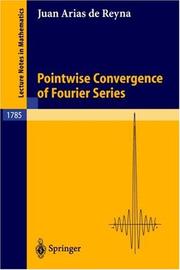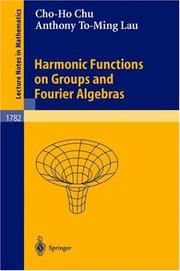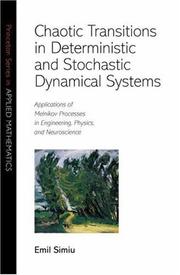| Listing 1 - 5 of 5 |
Sort by
|
Book
ISBN: 1316036588 Year: 2002 Publisher: Cambridge : Cambridge University Press,
Abstract | Keywords | Export | Availability | Bookmark
 Loading...
Loading...Choose an application
- Reference Manager
- EndNote
- RefWorks (Direct export to RefWorks)
Professor Zygmund's Trigonometric Series, first published in Warsaw in 1935, established itself as a classic. It presented a concise account of the main results then known, but was on a scale which limited the amount of detailed discussion possible. A greatly enlarged second edition published by Cambridge in two volumes in 1959 took full account of developments in trigonometric series, Fourier series and related branches of pure mathematics since the publication of the original edition. The two volumes are here bound together with a foreword from Robert Fefferman outlining the significance of this text. Volume I, containing the completely rewritten material of the original work, deals with trigonometric series and Fourier series. Volume II provides much material previously unpublished in book form.
Book
ISBN: 9780521890533 9781316036587 Year: 2002 Publisher: Cambridge Cambridge University Press
Abstract | Keywords | Export | Availability | Bookmark
 Loading...
Loading...Choose an application
- Reference Manager
- EndNote
- RefWorks (Direct export to RefWorks)

ISBN: 3540432701 3540458220 9783540432708 Year: 2002 Volume: 1785 Publisher: Berlin Springer-Verlag
Abstract | Keywords | Export | Availability | Bookmark
 Loading...
Loading...Choose an application
- Reference Manager
- EndNote
- RefWorks (Direct export to RefWorks)
This book contains a detailed exposition of Carleson-Hunt theorem following the proof of Carleson: to this day this is the only one giving better bounds. It points out the motivation of every step in the proof. Thus the Carleson-Hunt theorem becomes accessible to any analyst.The book also contains the first detailed exposition of the fine results of Hunt, Sjölin, Soria, etc on the convergence of Fourier Series. Its final chapters present original material. With both Fefferman's proof and the recent one of Lacey and Thiele in print, it becomes more important than ever to understand and compare these two related proofs with that of Carleson and Hunt. These alternative proofs do not yield all the results of the Carleson-Hunt proof. The intention of this monograph is to make Carleson's proof accessible to a wider audience, and to explain its consequences for the pointwise convergence of Fourier series for functions in spaces near $äcal Lü^1$, filling a well-known gap in the literature.
Fourier series --- Convergence. --- Convergence --- Mathematical Theory --- Operations Research --- Civil & Environmental Engineering --- Mathematics --- Engineering & Applied Sciences --- Physical Sciences & Mathematics --- Fourier analysis. --- Fourier Analysis. --- Analysis, Fourier --- Mathematical analysis

ISSN: 00758434 ISBN: 3540435956 3540477934 9783540435952 Year: 2002 Volume: 1782 Publisher: Berlin: Springer,
Abstract | Keywords | Export | Availability | Bookmark
 Loading...
Loading...Choose an application
- Reference Manager
- EndNote
- RefWorks (Direct export to RefWorks)
This research monograph introduces some new aspects to the theory of harmonic functions and related topics. The authors study the analytic algebraic structures of the space of bounded harmonic functions on locally compact groups and its non-commutative analogue, the space of harmonic functionals on Fourier algebras. Both spaces are shown to be the range of a contractive projection on a von Neumann algebra and therefore admit Jordan algebraic structures. This provides a natural setting to apply recent results from non-associative analysis, semigroups and Fourier algebras. Topics discussed include Poisson representations, Poisson spaces, quotients of Fourier algebras and the Murray-von Neumann classification of harmonic functionals.
Locally compact groups. --- Banach algebras. --- Locally compact groups --- Banach algebras --- Harmonic functions --- Operations Research --- Mathematical Theory --- Civil & Environmental Engineering --- Mathematics --- Engineering & Applied Sciences --- Physical Sciences & Mathematics --- Harmonic analysis. --- Potential theory (Mathematics). --- Integral equations. --- Topological groups. --- Lie groups. --- Functional analysis. --- Functions of complex variables. --- Abstract Harmonic Analysis. --- Potential Theory. --- Integral Equations. --- Topological Groups, Lie Groups. --- Functional Analysis. --- Several Complex Variables and Analytic Spaces. --- Complex variables --- Elliptic functions --- Functions of real variables --- Functional calculus --- Calculus of variations --- Functional equations --- Integral equations --- Groups, Lie --- Lie algebras --- Symmetric spaces --- Topological groups --- Groups, Topological --- Continuous groups --- Equations, Integral --- Functional analysis --- Green's operators --- Green's theorem --- Potential functions (Mathematics) --- Potential, Theory of --- Mathematical analysis --- Mechanics --- Analysis (Mathematics) --- Functions, Potential --- Potential functions --- Calculus --- Bessel functions --- Fourier series --- Time-series analysis

ISBN: 0691050945 1400832500 9781400832507 9780691144344 0691144346 9780691144344 9780691050942 Year: 2002 Publisher: Princeton, New Jersey
Abstract | Keywords | Export | Availability | Bookmark
 Loading...
Loading...Choose an application
- Reference Manager
- EndNote
- RefWorks (Direct export to RefWorks)
The classical Melnikov method provides information on the behavior of deterministic planar systems that may exhibit transitions, i.e. escapes from and captures into preferred regions of phase space. This book develops a unified treatment of deterministic and stochastic systems that extends the applicability of the Melnikov method to physically realizable stochastic planar systems with additive, state-dependent, white, colored, or dichotomous noise. The extended Melnikov method yields the novel result that motions with transitions are chaotic regardless of whether the excitation is deterministic or stochastic. It explains the role in the occurrence of transitions of the characteristics of the system and its deterministic or stochastic excitation, and is a powerful modeling and identification tool. The book is designed primarily for readers interested in applications. The level of preparation required corresponds to the equivalent of a first-year graduate course in applied mathematics. No previous exposure to dynamical systems theory or the theory of stochastic processes is required. The theoretical prerequisites and developments are presented in the first part of the book. The second part of the book is devoted to applications, ranging from physics to mechanical engineering, naval architecture, oceanography, nonlinear control, stochastic resonance, and neurophysiology.
Differentiable dynamical systems. --- Chaotic behavior in systems. --- Stochastic systems. --- Systems, Stochastic --- Stochastic processes --- System analysis --- Chaos in systems --- Chaos theory --- Chaotic motion in systems --- Differentiable dynamical systems --- Dynamics --- Nonlinear theories --- System theory --- Differential dynamical systems --- Dynamical systems, Differentiable --- Dynamics, Differentiable --- Differential equations --- Global analysis (Mathematics) --- Topological dynamics --- Affine transformation. --- Amplitude. --- Arbitrarily large. --- Attractor. --- Autocovariance. --- Big O notation. --- Central limit theorem. --- Change of variables. --- Chaos theory. --- Coefficient of variation. --- Compound Probability. --- Computational problem. --- Control theory. --- Convolution. --- Coriolis force. --- Correlation coefficient. --- Covariance function. --- Cross-covariance. --- Cumulative distribution function. --- Cutoff frequency. --- Deformation (mechanics). --- Derivative. --- Deterministic system. --- Diagram (category theory). --- Diffeomorphism. --- Differential equation. --- Dirac delta function. --- Discriminant. --- Dissipation. --- Dissipative system. --- Dynamical system. --- Eigenvalues and eigenvectors. --- Equations of motion. --- Even and odd functions. --- Excitation (magnetic). --- Exponential decay. --- Extreme value theory. --- Flow velocity. --- Fluid dynamics. --- Forcing (recursion theory). --- Fourier series. --- Fourier transform. --- Fractal dimension. --- Frequency domain. --- Gaussian noise. --- Gaussian process. --- Harmonic analysis. --- Harmonic function. --- Heteroclinic orbit. --- Homeomorphism. --- Homoclinic orbit. --- Hyperbolic point. --- Inference. --- Initial condition. --- Instability. --- Integrable system. --- Invariant manifold. --- Iteration. --- Joint probability distribution. --- LTI system theory. --- Limit cycle. --- Linear differential equation. --- Logistic map. --- Marginal distribution. --- Moduli (physics). --- Multiplicative noise. --- Noise (electronics). --- Nonlinear control. --- Nonlinear system. --- Ornstein–Uhlenbeck process. --- Oscillation. --- Parameter space. --- Parameter. --- Partial differential equation. --- Perturbation function. --- Phase plane. --- Phase space. --- Poisson distribution. --- Probability density function. --- Probability distribution. --- Probability theory. --- Probability. --- Production–possibility frontier. --- Relative velocity. --- Scale factor. --- Shear stress. --- Spectral density. --- Spectral gap. --- Standard deviation. --- Stochastic process. --- Stochastic resonance. --- Stochastic. --- Stream function. --- Surface stress. --- Symbolic dynamics. --- The Signal and the Noise. --- Topological conjugacy. --- Transfer function. --- Variance. --- Vorticity.
| Listing 1 - 5 of 5 |
Sort by
|

 Search
Search Feedback
Feedback About UniCat
About UniCat  Help
Help News
News